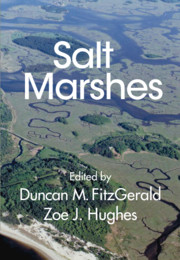Book contents
- Salt Marshes
- Salt Marshes
- Copyright page
- Contents
- Contributors
- Acknowledgments
- 1 State of Salt Marshes
- Part I Marsh Function
- 2 Salt Marsh Distribution, Vegetation, and Evolution
- 3 Salt Marsh Formation
- 4 Salt Marsh Hydrodynamics
- 5 Community Ecology of Salt Marshes
- 6 The Role of Marshes in Coastal Nutrient Dynamics and Loss
- Part II Marsh Dynamics
- Part III Marsh Response to Stress
- Index
- References
5 - Community Ecology of Salt Marshes
from Part I - Marsh Function
Published online by Cambridge University Press: 19 June 2021
- Salt Marshes
- Salt Marshes
- Copyright page
- Contents
- Contributors
- Acknowledgments
- 1 State of Salt Marshes
- Part I Marsh Function
- 2 Salt Marsh Distribution, Vegetation, and Evolution
- 3 Salt Marsh Formation
- 4 Salt Marsh Hydrodynamics
- 5 Community Ecology of Salt Marshes
- 6 The Role of Marshes in Coastal Nutrient Dynamics and Loss
- Part II Marsh Dynamics
- Part III Marsh Response to Stress
- Index
- References
Summary
Salt marshes have been useful study systems for community ecologists. They are amenable to experimental manipulation, and the simplicity and strong abiotic gradients of salt marshes lead to clear patterns and experimental outcomes. Many early ecologists believed that salt marsh ecosystems were primarily controlled by bottom-up factors (i.e., that nutrients, salinity, and other abiotic factors were the primary factors regulating productivity, and that productivity in turn regulated ecosystem trophic structure). More recently, many ecologists have argued that consumers have an important role in structuring salt marsh ecosystems through “top-down” processes. A simple conceptual approach, which we take here, is to think of salt marsh communities as being structured by bottom-up, top-down, and non-trophic processes.
Keywords
- Type
- Chapter
- Information
- Salt MarshesFunction, Dynamics, and Stresses, pp. 82 - 112Publisher: Cambridge University PressPrint publication year: 2021
References
- 4
- Cited by

